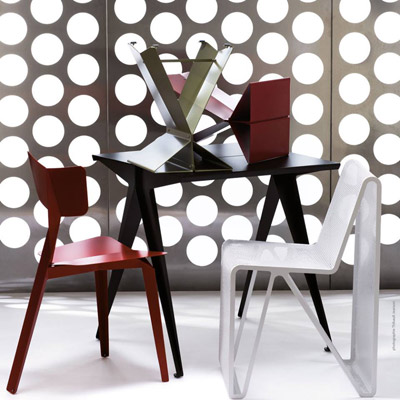|
|
||
|
January’s edition of the Parisian exhibition showed French designers in fine form, says Peter Smisek Visitor numbers at this year’s Maison & Objet have yet to be announced, but a quick chat to cloakroom attendants supports the suspicion that they could be lower than last year’s – given recent attacks, Paris is having a harder time attracting visitors. But this seemed to make little difference to the exhibitors: manufacturers and designers did show up in force to display their latest wares. This year’s theme was Silence. Given that the second day of M&O coincided with worldwide women’s marches, protest or resistance – a French specialty – might have been a more potent call to arms, though perhaps too radical for a commercial venture. Fortunately, in putting together the accompanying installation, Elizabeth Leriche pulled together a coherent array of recent minimalist designs, from Muller Van Severen’s Wire #1 chaise to Nendo’s Deep Sea cabinet for Glas Italia. The theme did little to infiltrate the main exhibition – bright colours, rotund shapes and a variety of materials were centre stage. The furniture launches were dominated by French brands, taking full advantage of their home turf. Petite Friture’s stand, the Villa P.F., was a crisp Memphis-infused modernist stage-set, which pulled together some of their old favourites with new fabrics and wallpapers by Shelley Steer and Tiphaine de Bodman. Bright colours notwithstanding, the blocky, modular Hoff – a new seating line by Morten & Jonas – has a simple, bulky form that contrasts with the brand’s more intricate furniture of earlier years.
Marie-Aurore Stiker-Metral’s Vivienne chair for Ligne Roset Ligne Roset and its slightly funkier brand Cinna (both marketed as Ligne Roset in the UK) occupied a large space in the ‘luxury’ section of the fair. Their new releases were pared down in form. There were some visual nods to tradition with Marie Christine Dorner’s opulent but visually pleasant Amédée sofa and armchair – an exercise in ‘comfort and lumbar support’, according to its designer. The stand, mostly filled with new launches and updated designs, also devoted a section to one of its most prominent collaborators, Pierre Charpin, who was named Maison & Objet’s designer of the year. Another standout was Marie-Aurore Stiker-Metral’s Vivienne chair: a somewhat austere, but visually balanced piece of furniture with echoes of Jean Prouvé’s work.
Adónde’s furniture made of folded metal for Ifé Prouvé’s influence seemed pervasive, both in aesthetic and ethos. The newly launched French brand Ifé released a collection of furniture made of folded metal, designed by Paris-based studio Adónde, which embodies both. Similarly, La Chance’s designers went to great lengths to aestheticise his constructional logic, albeit in a very mannered way. Other manufacturers had more modest updates, no doubt reserving new launches for Milan, but it was good to catch up with Gebrüder Thonet, under the leadership of former Gufram chief Riccardo Pigati since 2013, which has expanded its range of classic designs with new pieces from Martino Gamper, Nigel Coates and Gamfratesi, whose Targa range of sofas and armchairs is now available with brass-tipped legs.
Aino Aalto’s Riihitie plant pot for Artek – designed in 1937 but now in production As for the ‘objet’ part of the event, there were plenty of accessory debuts to go around. Vitra released a series of small Eames-designed mobiles, and even trays and napkins sporting Ray’s instantly recognisable dot pattern – in a bid to appeal to audiences that might not be able to afford the furniture. Artek, a Vitra subsidiary since 2013, released Rivi, a new textile pattern by the Bouroullec brothers, which also appears on cushions and trays, but swathes of the fabric are available for design and DYI-savvy consumers. Aino Aalto’s amoebic Riihitie plant pot – only exhibited once, at the 1937 Paris World’s Fair – has been taken into serial production, with a promise of more to come.
Forma cheesegrater by Zaha Hadid for Alessi The last unmissable presence was that of late British architect Zaha Hadid, whose design work featured prominently at the Swarowski Home display, as well as in the Zaha Hadid Design Collection, a self-initiated range of objects that encompasses everything from vases to chess sets to scented candles. The standout was her Forma cheesegrater, designed for Alessi – composed of a sinuous black base and a steel pebble-like container, which acts as the grater. Supremely ergonomic, it challenges our assumptions about form (perhaps all Zaha Hadid’s buildings could be refashioned into consumer products) and is by far the most interesting of Alessi’s 2017 releases, surpassing Daniel Libeskind’s water tower-shaped containers and Naoto Fukasawa’s normcore vessels. |
Words Peter Smisek |
|
|
||























